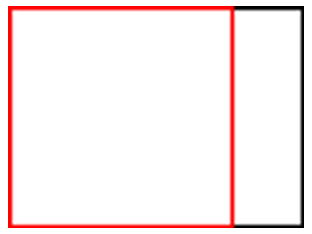Lines per Picture Height refers to the number of
TV Lines an analog TV can display in a 1:1 area of the screen. Since a standard
PAL or
NTSC TV has an
Aspect ratio (AR) of
4:3, this means an area with a 1:1
AR only includes 75% of the screen's width. For example, if a TV can produce 360
TV Lines across the screen that equates to 270 (360 x 0.75) Lines per Picture Height. The picture below indicates the 1:1 area of a 4:3 display with the red border.
 Calculating Lines per Picture Height
Calculating Lines per Picture Height
If you know the number of
TV Lines your analog television can reproduce you can easily determine the number of Lines per Picture Height by multiplying by 0.75. If you know the number of Lines per Picture Height and want to figure out the total number of
TV Lines reverse the operation and divide by 0.75.
Related Guides
Resizing DVD-Video To Square Pixels
Digital Video Fundamentals - Resolution and Aspect Ratio
Digital Video Fundamentals - Frames & Framerates

